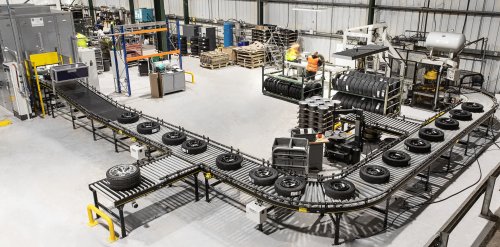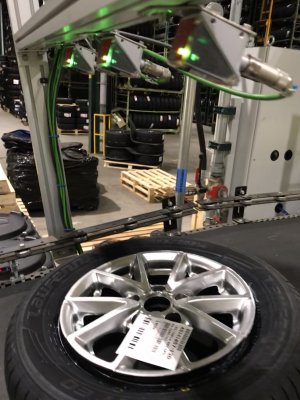2D-code readers get automation rolling
Autarky Automation is one of the leading British developers and manufacturers of automation and conveyor systems. To meet the demanding requirements on an automated tyre system, Autarky opted for the latest 2D-code readers from Leuze.

Figure 1: Automated conveyor application at Tyre-Line from assembly identification to tire inflation
A large part of what Autarky Automation offers is in the area of modular conveyor technology. Here, Autarky offers a wide range of standardized components and accessories. The company thereby contributes to minimizing project planning times and assembly costs. A good example of this is the project for Tyre-Line: Since 1984 the company has been supplying the industry with wheel and tire assemblies – from wheelbarrows to high-performance sports cars.
The task: conveyor system for tyre inflation.
For a long time, the tire line at Tyre-Line operated with a simple tire inflation device for standard steel wheel sets. The tires for high-end alloy wheels were inflated manually. Due to increasing growth in orders, a Hofmann tire filling machine was purchased that could handle the complete range of wheel and tire assemblies.
The entire process of storing and retrieving assemblies in the machine was now to be automated. Autarky won the tender to produce a suitable conveyor system and relied on Leuze.
Attached to each wheel and tire assembly at Tyre-Line is a slightly adhesive bar code label. It would have been too complicated for Tyre-Line to affix the label at exactly the same location on each assembly. Autarky was therefore charged with developing a solution that could reliably read the bar code. And could do so at any location and at any position over the entire width of the conveyor belt.
“A round object that always looks the same independent of its position is a true challenge for a code reader.
“Proper identification of the assemblies was, however, of decisive importance for the success of the line: the detection of the bar code information needed to tell the Hofmann machine which assembly is approaching and, thus, what air pressure is necessary. That’s why it was so important to select the best possible code reader for this task,” explains Brad North, managing director of Autarky. To solve this problem, Autarky turned to the Sensor People at Leuze.
The solution: the DCR 200i from Leuze.
After discussing the application with the Leuze experts, we selected the DCR 200i 2D-code reader,” explains North. Leuze, a leading manufacturer of bar code readers with more than 50 years of experience, developed this model especially for fast and omnidirectional reading of 1D- and 2D-codes.
“We mounted three devices on a strap arrangement at the optimum angle and height so that the bar code could be read at any position on the assembly and the conveyor belt.
“In combination with the existing PROFINET communication network, the DCR 200i 2D-code readers from Leuze detect data on the bar code. This is then passed on to the Hofmann machine.” Autarky had already used hundreds of standard bar code readers and photoelectric sensors from Leuze. “Our longstanding cooperation with Leuze and the good service made the decision easy for us,” says Brad North.
The DCR 200i camera-based code reader is used to detect and identify bar codes, stacked codes and Data Matrix codes. It is characterized above all by its very fast reading performance. The DCR 200i achieves speeds of up to 6 m/s. It reliably reads 1D- and 2D-codes omnidirectionally. It plays no role here whether they are printed or directly marked, static or moving, inverted or mirrored. This is ensured by the fast imager, the integrated high-performance LED illumination, as well as the high resolution in combination with
a very high depth of field.
In the stainless steel housing model with degree of protection IP69K/IP67, the DCR 200i can be cleaned without problem and even used in harsh environments.
Its compact design, its fastening concept and its simple handling means that the DCR 200i can be integrated easily and quickly in a wide range of different applications. This applies to its mechanical installation as well as its commissioning and configuration.

Figure 2: Assembly identification using 2D bar code readers from Leuze
The code readers of the DCR 200i series are operated and configured using the graphical user interface of the integrated Leuze webConfig tool via an Ethernet interface. An external program is not required. The DCR 200i can be put into operation by the user in just three minutes using the configuration wizard. Moreover, the teach function is also a possibility. This is run using the two buttons on the control panel of the DCR 200i in combination with a smartphone app developed by Leuze for configuration.
“Today, a wheel and tire assembly passes through the inflation machine every seven seconds. In addition to the sheer speed, Tyre-Line also benefits from an increased inflation accuracy and repeatability. Because the automated system has eliminated any possibility for human error.”
The conclusion drawn by Autarky Managing Director Brad North is entirely positive:
“At Tyre-Line, the Leuze 2D-code readers now work daily from morning to evening and help the company achieve significantly higher throughputs rates.”
@TheSensorPeople @AutarkySales #PAuto



 Posted by Eoin Ó Riain
Posted by Eoin Ó Riain  If we compare the history of electric current with the 75 years of the history of
If we compare the history of electric current with the 75 years of the history of 
 When the technician came to the site, they may have found that they didn’t have the right tools, the right parts, or even the specific knowledge to carry out the service needed. This would mean the same technician would have to go back, or a second technician would need to come out to complete the service.
When the technician came to the site, they may have found that they didn’t have the right tools, the right parts, or even the specific knowledge to carry out the service needed. This would mean the same technician would have to go back, or a second technician would need to come out to complete the service.
 “Crucial to the selection of Westermo was that their products met our high standards and requirements for the project. This included fast communication performance, multiple routing ports per device, high MTBF periods, extended temperature ranges and very low power consumption,” said Rénald Marmet, project engineer at BKW Energie. “Another factor was the operation and parameterisation of the networking hardware via the WeOS operating system. Also, the extremely efficient and time-saving update capability provided by the WeConfig network management software, which enables the central configuration and management of all Westermo devices.”
“Crucial to the selection of Westermo was that their products met our high standards and requirements for the project. This included fast communication performance, multiple routing ports per device, high MTBF periods, extended temperature ranges and very low power consumption,” said Rénald Marmet, project engineer at BKW Energie. “Another factor was the operation and parameterisation of the networking hardware via the WeOS operating system. Also, the extremely efficient and time-saving update capability provided by the WeConfig network management software, which enables the central configuration and management of all Westermo devices.”






 A very striking presentation was given by Dirk Reineld, Senior VP Indirect Procurement with BASF. He brought us to the top of Rome’s Via de Conciliazione on 19th April 2005. We saw the huge crowd looking towards the centre balcony as the election of a new pope was announced. He then moved forward to the 13th March in 2013, the same place but what a difference in such a short time. This time it seemed that everybody had a mobile phone held to take photographs of the announcement of the election of Francis. All we could see was a sea of little screens. He used this to emphasize a point “We are underestimating what is happening & its speed.” This is not helped by a natural conservatism among plant engineers. Change is happening and we either embrace it or get left behind. It is becoming more and more clear that in front of us “the path is digital!” He presented some useful examples of digitalisation and collaboration at BASF.
A very striking presentation was given by Dirk Reineld, Senior VP Indirect Procurement with BASF. He brought us to the top of Rome’s Via de Conciliazione on 19th April 2005. We saw the huge crowd looking towards the centre balcony as the election of a new pope was announced. He then moved forward to the 13th March in 2013, the same place but what a difference in such a short time. This time it seemed that everybody had a mobile phone held to take photographs of the announcement of the election of Francis. All we could see was a sea of little screens. He used this to emphasize a point “We are underestimating what is happening & its speed.” This is not helped by a natural conservatism among plant engineers. Change is happening and we either embrace it or get left behind. It is becoming more and more clear that in front of us “the path is digital!” He presented some useful examples of digitalisation and collaboration at BASF.

 Using this we could embark on a journey through products, services and solutions where Emerson together with their partners could help solve operational and project challenges.
Using this we could embark on a journey through products, services and solutions where Emerson together with their partners could help solve operational and project challenges.
 The following morning there were a series of automation forum dedicated to various sectors. The
The following morning there were a series of automation forum dedicated to various sectors. The  Each evening there were social events which provided further opportunities for networking. One of these was a visit to the iconic
Each evening there were social events which provided further opportunities for networking. One of these was a visit to the iconic  These are the most viewed stories on the Read-out Instrumentation Signpost website during 2017. The article on Radar Level Management (item 2 on this list) by Emerson’s Sarah Parker, has consistantly appeared somewhere on this annual list in the last seven years.
These are the most viewed stories on the Read-out Instrumentation Signpost website during 2017. The article on Radar Level Management (item 2 on this list) by Emerson’s Sarah Parker, has consistantly appeared somewhere on this annual list in the last seven years.










 NIDays welcomed hundreds of delegates from across Northern Europe to the historic Sandown Park Racecourse in England in
NIDays welcomed hundreds of delegates from across Northern Europe to the historic Sandown Park Racecourse in England in 












